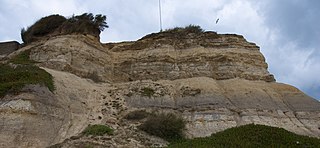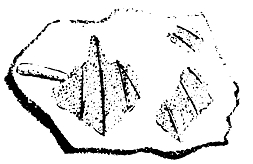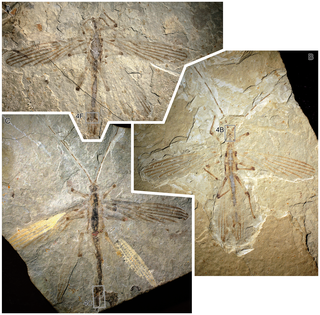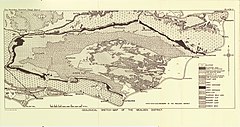
Jurodidae is a family of beetles that was originally described for the extinct genus Jurodes, known from the Middle-Late Jurassic of Asia. In 1996, a living species, Sikhotealinia zhiltzovae was discovered in the Sikhote-Alin mountains in southeastern Siberia, and assigned to this family. Their placement is uncertain, but are usually considered archostematans. In one study, Sikhotealinia and Jurodes were considered a sister group to all other archostematan beetles. However, other authors have considered their placement within beetles as a whole uncertain, due to their mix characteristics of typical Archostemata, as well as Polyphaga and Adephaga.

The Wealden Group, occasionally also referred to as the Wealden Supergroup, is a group in the lithostratigraphy of southern England. The Wealden group consists of paralic to continental (freshwater) facies sedimentary rocks of Berriasian to Aptian age and thus forms part of the English Lower Cretaceous. It is composed of alternating sands and clays. The sandy units were deposited in a flood plain of braided rivers, the clays mostly in a lagoonal coastal plain.

The Wessex Formation is a fossil-rich English geological formation that dates from the Berriasian to Barremian stages of the Early Cretaceous. It forms part of the Wealden Group and underlies the younger Vectis Formation and overlies the Durlston Formation. The dominant lithology of this unit is mudstone with some interbedded sandstones. It is part of the strata of the Wessex Basin, exposed in both the Isle of Purbeck and the Isle of Wight. While the Purbeck sections are largely barren of vertebrate remains, the Isle of Wight sections are well known for producing the richest and most diverse fauna in Early Cretaceous Europe.

The Yixian Formation is a geological formation in Jinzhou, Liaoning, People's Republic of China, that spans about 1.6 million years during the early Cretaceous period. It is known for its fossils, listed below.
Proraphidia is a genus of snakefly in the extinct family Mesoraphidiidae. The genus currently contains three species; Proraphidia gomezi from the La Pedrera de Rúbies Formation in Spain, Proraphidia hopkinsi from the Weald Clay in England, and the type species Proraphidia turkestanica from Kazakhstan. The genus was first described by O. M. Martynova in 1941 with the publication of P. turkestanica from Jurassic deposits of the Karabastau Formation in Karatau, Kazakhstan.

Cyllonium is a genus of extinct insects. It contains two species.

Palaeontinidae, commonly known as giant cicadas, is an extinct family of cicadomorphs. They existed from the Late Triassic to the Early Cretaceous. The family contains around 30 to 40 genera and around a hundred species.

The Wadhurst Clay Formation is a geological unit which forms part of the Wealden Group and the middle part of the now unofficial Hastings Beds. These geological units make up the core of the geology of the High Weald in the English counties of West Sussex, East Sussex and Kent.
Brochocoleus is an extinct genus of beetles in the family Ommatidae, known from the Early Jurassic to the Early Late Cretaceous. 9 species are currently recognised, with many species being reassigned to other genera by Kirejtshuk's major systematic revision in 2020.
Zygadenia is an extinct genus of archostematan beetles from the Jurassic to Cretaceous. It is considered to be a senior synonym of Notocupes by Kirejtshuk (2020), but other researchers suggest to reserve the genus Zygadenia as a form taxon for isolated elytra that probably belong to the genus Notocupes, while retaining Notocupes as a valid genus for complete body fossils.
Principiala is an extinct genus of lacewing in the moth lacewings family Ithonidae. The genus is known from Cretaceous fossils found in South America, Europe, and possibly Asia. The genus is composed of two species, the type species Principiala incerta, and Principiala rudgwickensis.

Cretophasmomima is an extinct genus of stem group-stick insect from the Cretaceous of Eurasia and is one of the oldest and most basal stick insects known, it belongs to the Susumanioidea.
2018 in paleoentomology is a list of new fossil insect taxa that were described during the year 2018, as well as other significant discoveries and events related to paleoentomology that were scheduled to occur during the year.
2019 in paleoentomology is a list of new fossil insect taxa that were described during the year 2019, as well as other significant discoveries and events related to paleoentomology that were scheduled to occur during the year.
2017 in paleoentomology is a list of new fossil insect taxa that were described during the year 2017, as well as other significant discoveries and events related to paleoentomology that were scheduled to occur during the year.
2020 in paleoentomology is a list of new fossil insect taxa that were described during the year 2020, as well as other significant discoveries and events related to paleoentomology that were scheduled to occur during the year.
2015 in paleoentomology is a list of new fossil insect taxa that were described during the year 2016, as well as other significant discoveries and events related to paleoentomology that were scheduled to occur during the year.
2015 in paleoentomology is a list of new fossil insect taxa that were described during the year 2015, as well as other significant discoveries and events related to paleoentomology that were scheduled to occur during the year.

Elcanidae are an extinct family of Mesozoic and early Cenozoic orthopterans. Members of the family are distinguished by the presence of spurs on the distal part of the metatibia, unique among orthopterans, these have been suggested to have been used for controlling gliding, swimming aids, or for jumping on water. The group combines characteristics from both major groups of orthopterans, with long antennae and nymphal morphology similar to Ensifera, but with wing venation and adult morphology more similar to Caelifera. Elcanidae is part of Elcanoidea, which is thought to have diverged from living orthopterans by the beginning of the Permian, around 300 million years ago. The family also includes Permelcanidae, known from the Early-Late Permian. The relationship of Elcanoidea to Ensifera and Caelifera is currently unresolved. Elcanids are known from the Late Triassic to Paleocene of Eurasia, North and South America. Some members of the group exhibited aposematic coloration.
Angarosphecidae is an extinct family of Mesozoic and early Cenozoic wasps in the superfamily Apoidea.















